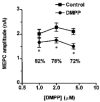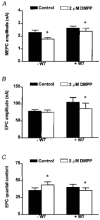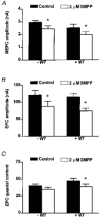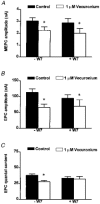Prejunctional effects of the nicotinic ACh receptor agonist dimethylphenylpiperazinium at the rat neuromuscular junction
- PMID: 9706022
- PMCID: PMC2231127
- DOI: 10.1111/j.1469-7793.1998.451bh.x
Prejunctional effects of the nicotinic ACh receptor agonist dimethylphenylpiperazinium at the rat neuromuscular junction
Abstract
1. We have studied the effects of the nicotinic acetylcholine (ACh) receptor agonist dimethylphenylpiperazinium (DMPP) on the evoked release of ACh from motor terminals in the rat isolated hemidiaphragm using an electrophysiological approach. 2. DMPP (1-4 microM) had no effect on the rate of spontaneous quantal ACh release but increased the number of quanta of ACh released per impulse during 50 Hz stimulation. The DMPP-induced increase in evoked ACh release was dependent on the frequency of stimulation, being absent when it was reduced to 0.5 Hz, but was not Ca2+ dependent, being unaffected at 50 Hz by a 4-fold decrease in the extracellular Ca2+ concentration. 3. The facilitation of evoked ACh release at 50 Hz by 2 microM DMPP was abolished by 10 microM of the calmodulin antagonist W7 (N-(6-aminohexyl)-5-chloro-1-naphthalenesulphonamide hydrochloride) and, in the presence of W7, 2 microM DMPP depressed evoked ACh release at 0.5 Hz. The ability of the nicotinic ACh receptor antagonist vecuronium (1 microM) to depress evoked ACh release at 50 Hz was also abolished by 10 microM W7. 4. The present findings demonstrate, using an electrophysiological technique, that DMPP can produce changes in the evoked ACh release from rat motor nerve terminals that are consistent with the existence of facilitatory nicotinic ACh receptors on the motor nerve endings. Further, they indicate a role for calmodulin-dependent systems in this facilitatory effect of the compound.
Figures







Similar articles
-
Factors influencing the low-frequency associated nicotinic ACh autoreceptor-mediated depression of ACh release from rat motor nerve terminals.Br J Pharmacol. 2000 Mar;129(6):1067-74. doi: 10.1038/sj.bjp.0703161. Br J Pharmacol. 2000. PMID: 10725254 Free PMC article.
-
Nicotinic antagonist-produced frequency-dependent changes in acetylcholine release from rat motor nerve terminals.J Physiol. 1994 May 1;476(3):517-29. doi: 10.1113/jphysiol.1994.sp020151. J Physiol. 1994. PMID: 7914535 Free PMC article.
-
Effects of lobeline and dimethylphenylpiperazinium iodide (DMPP) on N-methyl-D-aspartate (NMDA)-evoked acetylcholine release in vitro: evidence for a lack of involvement of classical neuronal nicotinic acetylcholine receptors.Neuropharmacology. 1997 Jan;36(1):39-50. doi: 10.1016/s0028-3908(96)00162-1. Neuropharmacology. 1997. PMID: 9144640
-
[The action of non-depolarizing muscle relaxants on nerve terminal of motor endplate--relationship between run-down of endplate potentials and fading tension response].Masui. 1994 Oct;43(10):1446-53. Masui. 1994. PMID: 7815692 Review. Japanese.
-
Prejunctional actions of muscle relaxants: synaptic vesicles and transmitter mobilization as sites of action.Gen Pharmacol. 1995 Jul;26(4):659-66. doi: 10.1016/0306-3623(94)00246-j. Gen Pharmacol. 1995. PMID: 7635241 Review.
Cited by
-
Mechanism of P2X7 receptor-dependent enhancement of neuromuscular transmission in pannexin 1 knockout mice.Purinergic Signal. 2018 Dec;14(4):459-469. doi: 10.1007/s11302-018-9630-7. Epub 2018 Oct 25. Purinergic Signal. 2018. PMID: 30362043 Free PMC article.
-
Neuromuscular effects of candoxin, a novel toxin from the venom of the Malayan krait (Bungarus candidus).Br J Pharmacol. 2003 Jun;139(4):832-44. doi: 10.1038/sj.bjp.0705299. Br J Pharmacol. 2003. PMID: 12813007 Free PMC article.
-
ACh Transfers: Homeostatic Plasticity of Cholinergic Synapses.Cell Mol Neurobiol. 2023 Mar;43(2):697-709. doi: 10.1007/s10571-022-01227-2. Epub 2022 May 28. Cell Mol Neurobiol. 2023. PMID: 35643882 Free PMC article. Review.
-
Factors influencing the low-frequency associated nicotinic ACh autoreceptor-mediated depression of ACh release from rat motor nerve terminals.Br J Pharmacol. 2000 Mar;129(6):1067-74. doi: 10.1038/sj.bjp.0703161. Br J Pharmacol. 2000. PMID: 10725254 Free PMC article.
-
Calmodulin increases transmitter release by mobilizing quanta at the frog motor nerve terminal.Br J Pharmacol. 2002 Nov;137(5):719-27. doi: 10.1038/sj.bjp.0704923. Br J Pharmacol. 2002. PMID: 12381686 Free PMC article.
References
-
- Bahlar M, Greengard P. Synapsin-I bundles F-actin in a phosphorylation-dependent manner. Nature. 1987;326:704–707. 10.1038/326704a0. - DOI - PubMed
-
- Barstad JAB, Lilliheil G. Transversaly cut diaphragm preparation from the rat. Archives Internationales de Pharmacodynamie et de Therapie. 1968;175:373–390. - PubMed
-
- Benfenati F, Valtorta F, Rubenstein JL, Gorelick FS, Greengard P, Czernik AJ. Synaptic vesicle-associated Ca2+/calmodulin-dependent protein kinase-II is a binding protein for synapsin-I. Nature. 1992;359:417–420. - PubMed
Publication types
MeSH terms
Substances
LinkOut - more resources
Full Text Sources
Miscellaneous

